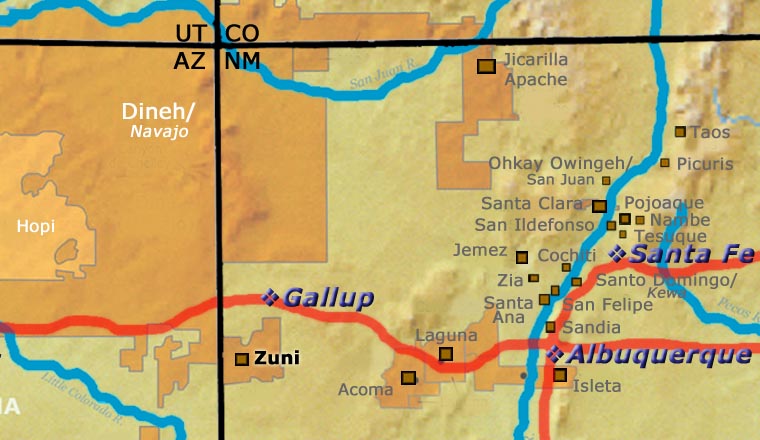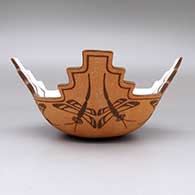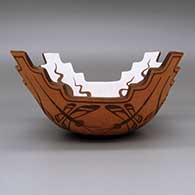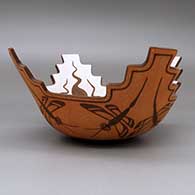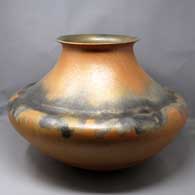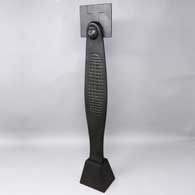
Randy Nahohai
Zuni
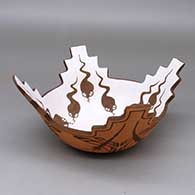
Randy Nahohai was born into the Eagle Clan at Zuni Pueblo in 1957. He sat in on a few of Jennie Laate's pottery classes at Zuni High School while he was there. However, he says he really learned the fine art of making pottery the traditional Zuni way, from his mother, Josephine Nahohai. Josephine herself had learned from her own mother and from attending Daisy Hooee's classes at Zuni High.
Daisy Hooey was Nampeyo of Hano's granddaughter. She had worked directly with Nampeyo for several years, forming her own pots and painting some of Nampeyo's. Before she took the job at Zuni High she studied and worked and turned herself into a consummate Zuni potter. Then she stepped into the classroom. Randy came along after Daisy had retired and Jennie Laate was teaching the ceramics classes.
After graduating from high school Randy attended the Institute of American Indian Arts and studied ceramics. He began actively producing pottery around 1983.
In 1985 Josephine Nahohai was awarded the Katrin H. Lamon Fellowship from the School of American Research. The stipend with that fellowship allowed her to take her sons Milford and Randy, and Randy's wife Rowena, with her to the East Coast to study old Zuni and Hawikuh pottery. Sisters Irene Nahohai and Priscilla Tsethlikai stayed behind at Zuni.
The pottery they went to study was in the collections at the Museum of the American Indian and at the Smithsonian Institute in Washington, DC. Randy and Milford learned a lot on that trip and were inspired to reproduce many of the historic shapes, designs and paints they'd seen.
Randy, Milford and Josephine shared a booth at the Santa Fe Indian Market for years, beginning in 1986. He became active as a potter in the marketplace in 1983 and mostly made polychrome and fine line white ware and orange ware: jars, cornmeal bowls, ollas, Corn Maiden sculptures and clay flutes in the shape of a frog. He also made bronzes and pen & ink drawings and worked with pastels.
Randy's favorite designs were deer with heart lines, long-haired katsinas, flute players, frogs, dragonflies and Kolowisi (the Zuni water serpent). He shared his pottery studio, Nahohai Clayworks, with Milford and they often collaborated with each other and with their mother. Randy passed on in 2016.
100 West San Francisco Street, Santa Fe, New Mexico 87501
(505) 986-1234 - www.andreafisherpottery.com - All Rights Reserved

Zuni Pueblo
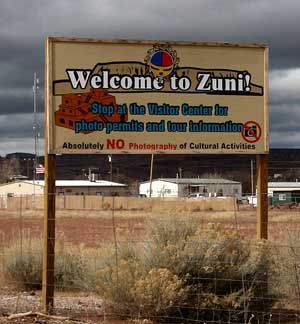
Welcome sign at Zuni Pueblo
Archaeologists have dated some sites on the Zuni Reservation back to the Paleo-Indian Period, more than 4,500 years ago. During the Archaic Period (2,500 BC to 0 AD), the forebears of the Zuni were hunter-gatherers and just beginning to develop agriculture. The Basketmaker Period (0 AD to 700 AD) saw agriculture become more developed and the Zunis were making their first pottery. The Pueblo I Period (700 AD to 1100 AD) saw an expansion of the population and larger settlements were built in the Zuni River area along with the development of the first painted Zuni pottery.
The Pueblo III Period (from 1100 to 1300 AD) saw further population growth in the Zuni River area and a shift from small houses to larger, plaza-oriented villages. The Pueblo IV Period (1300 to 1500 AD) was the time of the great drought and migrations as many tribal groups abandoned the Four Corners area and moved to locations near the Rio Grande, Rio Puerco, Zuni River and Little Colorado River. The main Zuni Pueblo was founded during this time but there were several other large villages in the area, too.
In 1540 there was a major battle fought between the Zunis and the forces of Francisco Vasquez de Coronado. Coronado first approached the pueblo at the end of a four-day religious festival. The Zunis had spilled a line of corn meal across the ground before the entrance to the pueblo, meant to signify to the Spanish that they shouldn't cross the line yet. Coronado interpreted that line of corn meal as an act of war and immediately ordered his soldiers to attack.
Coronado was almost killed in the fighting but his soldiers did finally win the battle. As Coronado and his men brought horses and sheep with them, they were probably the first such livestock the Zunis had ever seen. The gold the Spaniards were looking for: it turned out to be Sikyatki Polychrome bowls and jars, yellow clay gifts from the Hopis to the Zunis.
The Zunis did equip Coronado with a guide from the eastern Plains, someone who'd somehow made his way as a lone traveler to Hawikku. That refugee was supposed to be a guide for Coronado and his men but he was instructed by the Zunis to take Coronado into the Plains and get him lost there. When Coronado finally realized that, more than a year later, he ordered the guide executed, then turned his men around and headed back to Zuni and Mexico.
When he passed by Zuni in 1542, he left three Mexican Indians behind with the tribe. They most likely informed the tribal leaders of the extent of the Spanish domain in Mexico and the power they exercised there.
Except for a couple passing exploratory expeditions, they were left alone until the 1620s. Then came the friars who oversaw the construction of a mission church at Hawikku in 1629. At first the Zunis were friendly with the priests but with the forced labor requirements and forced religious conversions, the priests wore that welcome out quickly. Relations had changed drastically for the worse by the time of the Pueblo Revolt of 1680. The Zunis killed the priests and burned the missions but they preserved the relics and icons the priests had brought from Spain.
The tribe built a village near their fortress at Dowa Yalanne and prepared to defend their people and way of life against the Spanish army. When Don Diego de Vargas arrived with troops in 1692, he attacked the fortress twice and failed. Then he negotiated with the Zuni war chief and was allowed to ascend to the top of Dowa Yalanne. He found many relics from the destroyed missions there. With that knowledge, he arranged a peace between the Spanish and the tribe. Between 1693 and 1700 the tribe consolidated all their small villages into what is now the Pueblo of Zuni.
The railroads arrived in New Mexico in the 1880s and right behind them came the first Anglo traders. Over the next 50 years Zuni pottery turned more and more to what the traders wanted. With the push into mass production, the quality fell off. The end result was the value of Zuni pottery fell way off and the potters tired of what they were doing. Pottery making dropped off in the 1940s until only ceremonial vessels were being made. Catalina Zunie was teaching pottery making at the Zuni Day School through this time period but the Zuni pottery revival didn't really begin until Daisy Hooee began teaching pottery making at Zuni High School in the 1960s and 1970s.
An accomplished Hopi-Tewa potter with an excellent pedigree, Daisy applied herself to learning about Zuni pottery and became a consummate Zuni potter. She retired from teaching at the high school in 1974. Jennie Laate, an Acoma woman who married into Zuni and learned the Zuni way from Daisy Hooee, took over teaching the classes. Many of today's well known Zuni potters thank Jennie Laate for her teaching and inspiration. She taught until 1990 when she turned the classes over to her student, Noreen Simplicio. Noreen taught the classes for 2 years, then Gabriel Paloma took over.
Josephine Nahohai brought traditional Zuni pottery designs back into the community in the 1980s. Les Namingha has also recently been using more traditional Zuni shapes and designs in his Zuni revival pottery. Today, because so many Zuni potters learned their craft at Zuni High School, they mostly also use electric kilns for firing their works. Other than that, they all use the same traditional methods of gathering and processing the clay, making their pottery and painting their designs, traditional processes that are practiced in virtually the same way in all the pueblos.
100 West San Francisco Street, Santa Fe, New Mexico 87501
(505) 986-1234 - www.andreafisherpottery.com - All Rights Reserved

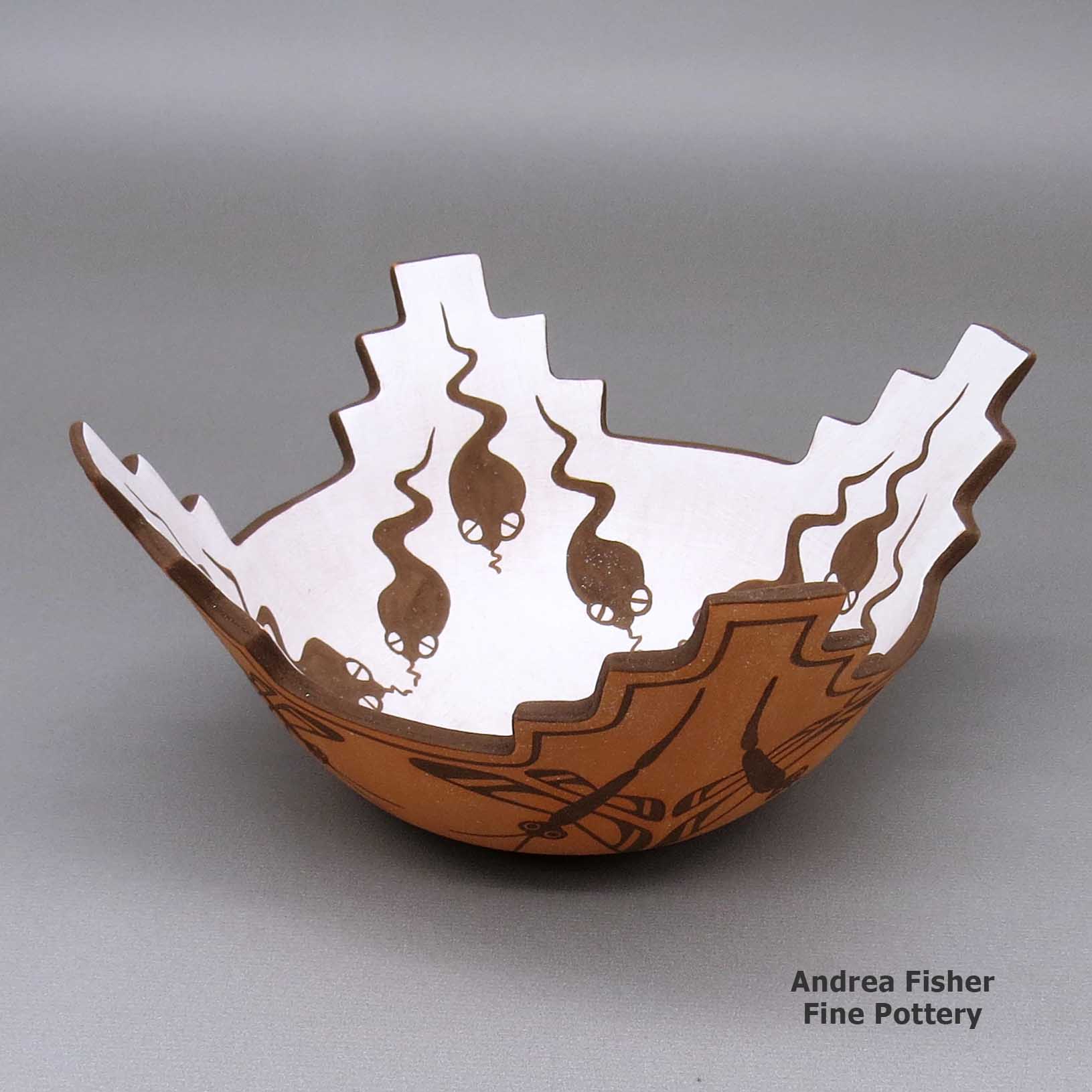
Randy Nahohai, Zuni, Polychromeprayerbowlwithmicaceousslipdetailsandapaintedtadpole,dragonfly,andgeometricdesign
Zuni
$ SOLD
llho3k482
Polychrome prayer bowl with micaceous slip details and a painted tadpole, dragonfly, and geometric design
7.5 in L by 7.5 in W by 3.5 in H
Condition: Very good, pencil marks on bottom and normal wear
Signature: R. Nahohai, with copyright symbol and N hallmark
Date Created: 2001
100 West San Francisco Street, Santa Fe, New Mexico 87501
(505) 986-1234 - www.andreafisherpottery.com - All Rights Reserved

Micaceous Clay Pottery

Angie Yazzie
Taos
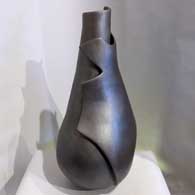
Christine McHorse
Navajo
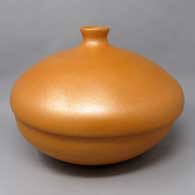
Clarence Cruz
San Juan/Ohkay Owingeh
Micaceous clay pots are the only truly functional Pueblo pottery still being made. Some special micaceous pots can be used directly on the stove or in the oven for cooking. Some are also excellent for food storage. Some people say the best beans and chili they ever tasted were cooked in a micaceous bean pot. Whether you use them for cooking or storage or as additions to your collection of fine art, micaceous clay pots are a beautiful result of centuries of Pueblo pottery making.
Between Taos and Picuris Pueblos is US Hill. Somewhere on US Hill is a mica mine that has been in use for centuries. Excavations of ancient ruins and historic homesteads across the Southwest have found utensils and cooking pots that were made of this clay hundreds of years ago.
Not long ago, though, the making of micaceous pottery was a dying art. There were a couple potters at Taos and at Picuris still making utilitarian pieces but that was it. Then Lonnie Vigil felt the call, returned to Nambe Pueblo from Washington DC and learned to make the pottery he became famous for. His success brought others into the micaceous art marketplace.
Micaceous pots have a beautiful shimmer that comes from the high mica content in the clay. Mica is a composite mineral of aluminum and/or magnesium and various silicates. The Pueblos were using large sheets of translucent mica to make windows prior to the Spaniards arriving. It was the Spanish who brought a technique for making glass. There are eight mica mining areas in northern New Mexico with 54 mines spread among them. Most micaceous clay used in the making of modern Pueblo pottery comes from several different mines near Taos Pueblo.
As we understand it, potters Robert Vigil and Clarence Cruz have said there are two basic kinds of micaceous clay that most potters use. The first kind is extremely micaceous with mica in thick sheets. While the clay and the mica it contains can be broken down to make pottery, that same clay has to be used to form the entire final product. It can be coiled and scraped but that final product will always be thicker, heavier and rougher on the surface. This is the preferred micaceous clay for making utilitarian pottery and utensils. It is essentially waterproof and conducts heat evenly.
The second kind is the preferred micaceous clay for most non-functional fine art pieces. It has less of a mica content with smaller embedded pieces of mica. It is more easily broken down by the potters and more easily made into a slip to cover a base made of other clay. Even as a slip, the mica serves to bond and strengthen everything it touches. The finished product can be thinner and have a smoother surface. As a slip, it can also be used to paint over other colors of clay for added effect. However, these micaceous pots may be a bit more water resistant than other Pueblo pottery but they are not utilitarian and will not survive utilitarian use.
While all micaceous clay from the area of Taos turns golden when fired, it can also be turned black by firing in an oxygen reduction atmosphere. Black fire clouds are also a common element on golden micaceous pottery.
Mica is a relatively common component of clay, it's just not as visible in most. Potters at Hopi, Zuni and Acoma have produced mica-flecked pottery in other colors using finely powdered mica flakes. Some potters at San Ildefonso, Santa Clara, Jemez and San Juan use micaceous slips to add sparkle to their pieces.
Potters from the Jicarilla Apache Nation collect their micaceous clay closer to home in the Jemez Mountains. The makeup of that clay is different and it fires to a less golden/orange color than does Taos clay. Some clay from the Picuris area fires less golden/orange, too. Christine McHorse, a Navajo potter who married into Taos Pueblo, uses various micaceous clays on her pieces depending on what the clay asks of her in the flow of her creating.
There is nothing in the makeup of a micaceous pot that would hinder a good sgraffito artist or light carver from doing her or his thing. There are some who have learned to successfully paint on a micaceous surface. The undecorated sparkly surface in concert with the beauty of simple shapes is a real testament to the artistry of the micaceous potter.
100 West San Francisco Street, Santa Fe, New Mexico 87501
(505) 986-1234 - www.andreafisherpottery.com - All Rights Reserved

Nahohai Family Tree
Disclaimer: This family tree is a best effort on our part to determine who the potters are in this group and arrange them in a generational order. This diagram is subject to change should we get better info.
- Josephine Nahohai & Nat Nahohai
- Irene Nahohai
- Irma Nahohai
- Dion Nahohai
- Maynard Nahohai
- Milford Nahohai
- Randy Nahohai & Rowena Him Nahohai
- Jaycee Nahohai
- Priscilla Tsethlikai
(505) 986-1234 - www.andreafisherpottery.com - All Rights Reserved
